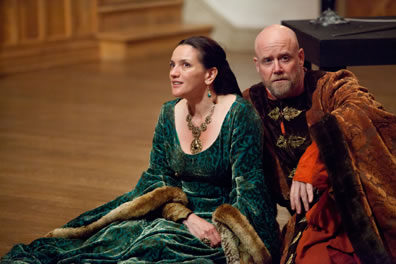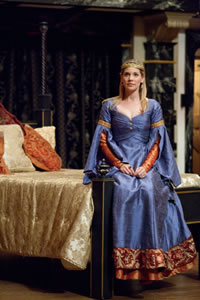The Lion in Winter
In a Play of Lions, Watch Out
For the Domestic Shorthair
By James Goldman
American Shakespeare Center, Blackfriars Theatre, Staunton, Va.
Saturday, July 14, 2012, C–6&7 (middle stalls)
Directed by Jim Warren
This 1966 stage play, pretty much a failure on Broadway, begot the movie, pretty much a dominant Academy Award-winning hit, which then rechristened the play as a modern classic, mounted in theaters at all levels. Of course, any theater production and its actors will forever be compared to the 1968 movie and O'Toole, Hepburn, Hopkins, Dalton, Terry, et al. But not the American Shakespeare Center's version of James Goldman's The Lion in Winter: This production and its actors must go up against their own previous work at the Blackfriars Playhouse, and that turns out to be stiffer competition than even O'Toole-Hepburn muster.

Tracy Hostmyer as Eleanor of Aquitaine and James Keegan as King Henry II in the American Shakespeare Center's production of The Lion in Winter at the Blackfriars Playhouse. Below, Tracie Thomason as Alais. Photos by Lauren D. Rogers, American Shakespeare Center.
The ASC is staging The Lion in Winter in tandem with Shakespeare's King John, which will join the repertory in the fall with the same actors playing John (John Harrell), Eleanor (Tracy Hostmyer), and France's King Philip (René Thornton Jr.), while Benjamin Curns, playing Richard in this play, takes on Richard's bastard son in the next. The plays may inform each other in some way, even if Lion was written in a 1960s idiom and King John in Elizabethan iambic pentameter; their juxtaposition, though, may be no more than a curiosity, which is perfectly fine for entertainment value. Most likely, though, the pairing will further reveal a curiouser thing about this company, which seldom if ever fails to bring Shakespeare and other Renaissance fare such as Middleton, Marlowe, and Jonson to breathing, in-the-moment life; but it seems to be merely performing this modern script. They perform it well, and it's handsomely presented with sumptuous period costumes by Erin M. West, but it still is merely live theater instead of the living theater we've come to expect at the Blackfriars.
Goldman's play is set during a royal Christmas feast at Chinon, France, as Henry II tries to choose an heir among his three surviving sons while playing a game of intense political intrigue with his queen, Eleanor; his mistress, Alais; her young brother, King Philip; and those three sons, Richard, Geoffrey, and John, all of whom want the crown. Despite its historical setting, The Lion in Winter is more family soap opera than historical drama, a Dynasty like that of the Carringtons rather than the dynasty of Plantagenets. It has more in kind with Edward Albee's shoutfest Who's Afraid of Virginia Woolf than Shakespeare's history cycles, swapping out George and Martha for Henry and Eleanor, psychologically slashing each other to shreds while they toy with Alais and the boys like Honey and so many Nicks. Because it is domestic theater, it talks a lot, with truth weaving in and out of conversations and confrontations in such a way you can't clearly delineate it from lies, feints, and faulty recollections. Then, the play suddenly ends, boom, in the exact same unresolved state as it started. Watching this utterly dysfunctional family for two-and-a-half-plus hours is our only take-away.
The play seems to rely on volume over nuance as the preferred method of building character. How loud can you rail? With how much snap can you bite off a sarcastic barb? The insults are funnier than the situations, the lines cleverer than the characters speaking them. The seven-member cast tackles the script with appropriate relish, but for all that, the play plods along in places and, at other times, we seem to be on a perpetual tape loop: Wait, didn't we already hear this conversation before? Nope, just round two or three of the heavyweight combatants, Henry and Eleanor—The Chilla in Chinon—and the welterweight undercard, Richard vs. Geoffrey. But it's the two lightweights and round card girl that stand out.
 John Harrell plays Prince John almost exactly as Richard describes him, a “walking pustule.” Harrell in his hunched shoulder, folded arms, and sniveling demeanor physically turns himself into a festering boil of a man. He's obnoxiously whiney and simpering when overmatched by his brothers, and even when he tries to play the sweet son he's grating. In his mastery of timing and concentrated timbre, Harrell expertly slides his lines in and out of the others' pronouncements, heightening the comic effect while making Prince John seem all the more annoying—like a mosquito buzzing around your ear.
John Harrell plays Prince John almost exactly as Richard describes him, a “walking pustule.” Harrell in his hunched shoulder, folded arms, and sniveling demeanor physically turns himself into a festering boil of a man. He's obnoxiously whiney and simpering when overmatched by his brothers, and even when he tries to play the sweet son he's grating. In his mastery of timing and concentrated timbre, Harrell expertly slides his lines in and out of the others' pronouncements, heightening the comic effect while making Prince John seem all the more annoying—like a mosquito buzzing around your ear.
Thornton's King Philip doesn't consider himself a lightweight, but he certainly is no match for the experienced manipulator and blowhard Henry—we can see James Keegan's King Henry deliciously outmaneuver his French counterpart at every turn. As Philip pulls what he thinks is the ace from up his sleeve in the bedchamber scene, Thornton ramps up the slyness in his character, the power of a man who this time has deeper knowledge than his adversary is aware of. And when that knowledge literally springs upon the scene even better than he could have imagined, Thornton's Philip sits back and watches his non-plot unfold and entwine Henry. This scene is worth attending the play twice: Watch the reveals of one son after another in the bedchamber the first time through, and the second go-round watch Thornton's Philip watching the unfolding show with his own delicious delight.
ASC newcomer Tracie Thomason plays Alais, Philip's sister and Henry's mistress, as the lightest weight of all, the resident eye candy. She's a sweet girl, devotedly doting on Henry, protesting that she's being used as a pawn even as the king so obviously maneuvers her. There is confidence in her bearing, though, even in the presence of Eleanor, and it's easy to dismiss that as a young woman's romantic fancies—until she lays down her own law on Henry that completely flummoxes him in a way the queen, princes, and royal counterpart never could. Frankly, we're not surprised in this plot twist because Thomason has subtly turned her pale part into an ever-emerging focal point, and that makes richer her last scene with Henry for being one of the most believable moments in this production—real, living theater.
The Lion in Winter is pleasant fare, and, as ASC present it, many of the barbs and asides are played for laughs, enhancing its entertainment value. Still, its chief value might be its purpose as a prequel to King John in the ASC's fall season. If Harrell is giving us a preview of his title role in that play, oh boy! That alone makes this production of The Lion in Winter worth viewing.
Eric Minton
July 20, 2012
Comment: e-mail editorial@shakespeareances.com
Start a discussion in the Bardroom



 Find additional Shakespeareances
Find additional Shakespeareances